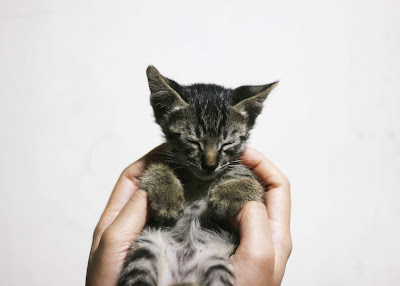breeding kitten
Breeding kitten (small cats)
What is a cat?
Cats are animals belonging to the group of felines that also include lion, tiger, righteousness, and lynx, which are small-sized carnivores covered with fur, known for their ability to familiarize themselves with humans and live in their cities, and there are about 70 breeds of domesticated cats around the world. Cats have strong claws that can spread or pull them under the skin whenever they want, as well as their jaws are filled with sharp teeth, making them ready to chase and kill small animals, such as mice, birds, and reptiles.
Cat ears are characterized by a high sensitivity to sounds, as it can capture the frequencies of the higher and lower sound waves than the human ear picks, and its eyes have a reflective layer behind it that helps them see even in almost complete darkness, and it can not distinguish the colors well, but it has a strong sense of smell. Cats live alone in areas they defend against intruders of their kind so that they are not subject to competition for game hunting in the area they own, yet cats are social beings. When you meet some of them, they communicate with a wide range of sounds and physical movements
Breeding small cats
Domestic cats, especially little ones, if they don't have a mother to care for, need a significant amount of care and attention. There are many needs for young cats that vary according to their age. For the first two months of a cat’s life, it can only live with its mother and siblings. The reason for this is that its bodies cannot regulate heat, so it depends on adherence to each other to keep itself warm as possible, as it needs to Special care, like feeding her every two hours, And a veterinarian should be consulted in this regard because of the seriousness of caring for a very small cat, but after the cat has reached the age of eight weeks it becomes somewhat strong and able to survive with a normal amount of care and can be treated healthy and nutritionally in the same way as adult cats. It is prescribed by cats to eat food from the age of forty-five days, and before that, you cannot eat or eat food. Young cats will need to eat additional amounts of food when their lifespan ranges between two and four months, because they grow very quickly at this stage, and after that, they are treated like completely adult cats.
cats food
Two-month-old cats can be fed many types of food, and it is desirable to provide them with cat foods available in the shops from well-known companies, as they are characterized by a high level of quality, and the veterinarian can help suggest the best types of food that must be provided to the cat, as this may vary Slightly according to her age, activity and health condition. Cat food must be balanced between the different nutrients. For example, cats need an amino acid called taurine to maintain the health of their eyes and heart, which can only be obtained through a balanced and studied diet. Be sure to constantly water the cat and refill its bowl whenever it gets short. On the other hand, be careful not to provide excess quantities of food for the cat, and if it shows signs of illness or refuses food for more than two days, it is advisable to take her to the vet.
read also :how to breed cat?
Health care
Domestic cats often do not need cleaning at all, as they can take care of their body alone and keep it clean to an acceptable degree, but brushing their fur with a brush from time to time may be useful for additional guarantees, and to reduce the amount of hair that leaves it at home. And all cats usually have their paws inserted into the things around them and constantly scratching them, which is a natural need that is difficult to control, and maybe a reason for destroying household furniture, such as curtains, sofas, carpets, etc., and to prevent the cat from doing this, it is necessary to trim its claws once every two weeks. Or three.
Cats prefer to have a special spot in the home that is dry and clean and has a dish to put food to be able to rest in comfort whenever it wants, but outside the cat may succeed in securing a suitable place for itself without interference from its owner. In general, many cat owners tend to keep their pets inside the house and not allow them to go out, and the reason for this is that the life of these creatures is always longer when they live inside a house, so their release increases the possibilities of exposing them to traffic accidents, or getting into a fight with other cats, Or in capturing diseases. If the cat is allowed to leave the house, it is advisable to hang a card on her neck bearing the owner's name and address, so that someone returns it if he finds it lost. Domestic cats should be taken to the veterinarian for a general examination at least once a year.
Biological properties of cats
All domesticated cats (or domestic or domestic cats as they are called distinctions from wild species) originate from a type of feline that began its relationship with humans in ancient Egypt approximately four thousand years ago, and ancient Egyptians used to take cats as pets for various reasons, which may be from The most important of these is their ability to hunt and hunt rodents from mice and rats that are harming their crops. Other than that, the Egyptians took one of their gods in the form of a cat, and some of the bodies of the cats they mummified were discovered just as humans were embalmed.
Cats can catch rodents very efficiently, and they often prefer to search for prey after dark, because of their ability (thanks to the reflecting layer behind their eyes) to see better than their prey themselves, and thus catch up easily. All cats communicate with each other by issuing a lot of meows, and they mark the areas around their areas by scattering their leftovers or the effects of their claws on the trees, fences, and surrounding furniture, so when another cat approaches, smells scent, or sees the signs, it moves away on its own.






